Indirect methods to determine soil water content are widely used in research and also in practical applications as an alternative to gravimetrical determination. These methods are called "indirect" because they do not measure soil water content directly, but they measure some other variable from which the soil water content can be calculated. Based on a known relationship between the actual soil water content and this variable, the soil water content can be determined more or less with accuracy.
The advantages of using indirect methods are clear: The indirect methods are non-destructive, measured data are immediately available, the measurement can be repeated several times in the same spot or the measurement can be taken continuously and operated by a computer. When the sensors are well calibrated, the measured data are accurate enough for most applications. The calibration is always carried out by comparison with the gravimetrical method. Below two indirect methods to determine soil water content which are presently widely used are presented.
On the video you can see an operating with a TDR sensor (TDR Trime - FM; Imko, GmbH.) and FDR sensors Theta Probe Soil Moisture Sensor ML2x (Delta-T Devices, Ltd.) and EC-5 Soil Moisture Sensor (Decagon Devices, Inc.).
TIME DOMAIN REFLECTOMETRY (TDR)
Principle
TDR is based on the evaluation of the speed by which a fast voltage pulse travels along a parallel transmission line inserted in the soil. The higher the dielectric constant of the soil in contact with the transmission line, the slower the speed of the voltage pulse. Because of the big difference between the dielectric constant of water and that of the other soil constituents (soil particles, air, …), the travel time of the pulse is essentially dependent on the volumetric water content of the soil (Topp et al., 1980).
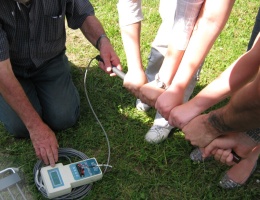
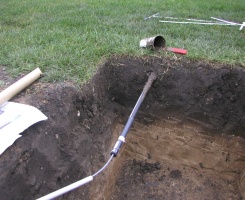
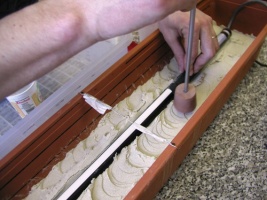

Materials and tools
TDR TRIME-FM (Imko, GmbH.), installation kit (stainless steel rods with the holder, hammer)

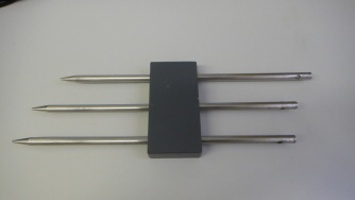

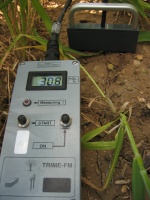
Important notes
- Pay special attention to the installation of the soil moisture sensor, avoid forcible application in the stony (rocky) areas. Use the stainless steel rods to prepare the holes for the measurement rods.
- Repeat the measurement several times.
- Do not forget to recharge the reading device’s battery before you take it to the field.
FREQUENCY DOMAIN (FD) CAPACITANCE and FREQUENCY DOMAIN REFLECTOMETRY (FDR)
Principle
The electrical capacitance of a capacitor that uses the soil as a dielectric depends on soil water content θ. When this capacitor, which is made of metal plates or rods imbedded in the soil, is connected to an oscillator to form an electrical circuit, changes in soil moisture can be detected by changes in the circuit operating frequency. These changes form the basis of the Frequency Domain (FD) technique which is used in Capacitance and Frequency Domain Reflectometry (FDR) sensors.
In capacitance sensors, a relative permittivity ε of soil is determined by measuring the charge time of a capacitor made with that soil. In FDR, the oscillator frequency is controlled within a certain range to determine the resonant frequency (at which the amplitude is greatest), which is a measure of water content in the soil (Muñoz-Carpena et al., 2006). Probes consist of two or more electrodes (e.g. plates or rods) that are inserted into the soil. When an electrical field is applied, the soil around the electrodes forms the dielectric of the capacitor to complete the oscillating circuit (see behind Photo 1 - 4 in one line - Frequency domain (FD) capacitance (rods); Photo of ECH2O – EC10 - Frequency domain (FD) capacitance where plates are embedded in a board). The measurements may be affected by temperature, salinity, bulk density and clay content, so a soil-specific calibration is recommended.
Materials and tools
Theta Probe Soil Moisture Sensor ML2x (ADR) and read-out and data storage device Moisture Meter HH2 (Delta-T Devices, Inc.),
ECH20 – EC-5 Soil Moisture Sensor (FDR) and read-out device ECH2O Check (Decagon Devices, Ltd.).
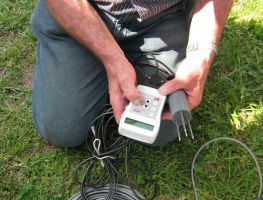
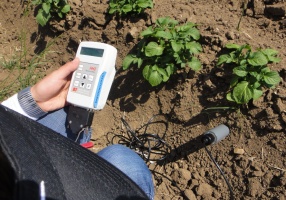
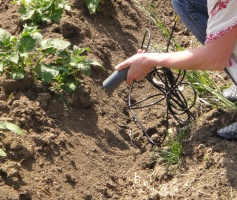

Important notes
- Before the measurement, the settings of the reading device need to be checked. Choose either generic (factory) or your own calibration equation.
- Pay special attention to the installation of the soil moisture sensor (ensure good contact with the soil).
- Repeat the measurement several times.
- Have a spare battery for the reading device in case you need it.
Example
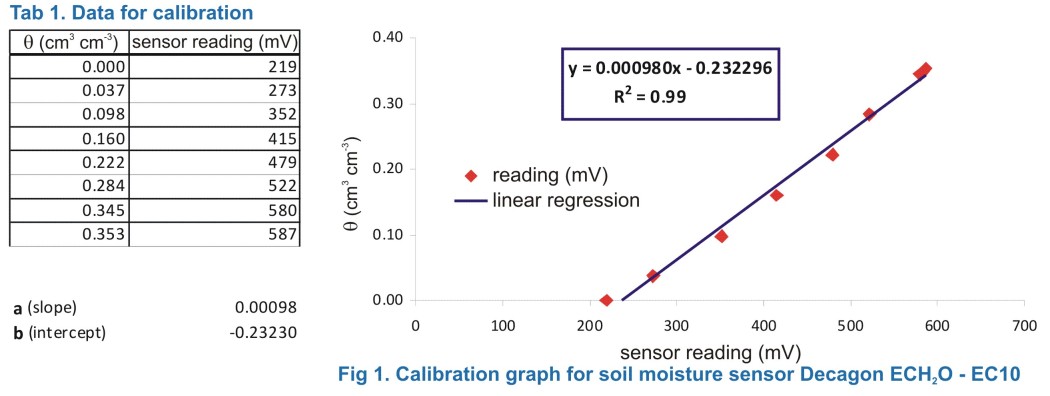
With the found calibration equation it is possible to determine the volumetric soil moisture content for any sensor reading in mV. For example, for the sensor reading 500 mV:
y = 0.00098 . 500 - 0.232296
y = 0.258 cm3 cm-3
The volumetric soil moisture content adequate to the sensor reading 500 mV is 0,258 cm3 cm-3.
References
Dirksen, Ch. (1999) Soil physics measurements. GeoEcology paperback. Catena Verlag, Reiskirchen, Germany. 154 pp. ISBN 3-923381-43-3.
Kutílek, M., Nielsen, D. (1994) Soil Hydrology. GeoEcology Textbook. Catena Verlag, Cremlingen-Destedt, Germany. 370 pp. ISBN 3-923381-26-3.
Muñoz-Carpena, R., Shukla, S., Morgan, K. (2006) Field devices for monitoring soil water content. Regional Extension Bulletin no. SR-IWM-2. The Irrigation Water Management Program Team of the Southern Regional Water Program. USDA-CSREES. Available at: http://www.bae.ncsu.edu/topic/go_irrigation/docs/Field-devices-monitoring-.pdf
Topp, G.C., Davis, J.L., Annan, A.P. (1980) Electromagnetic determination of soil water content: Measurements in coaxial transmission lines. Water Resources Research, 16, 574 – 582.











